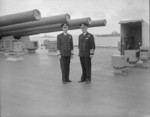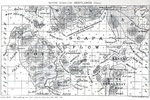Scapa Flow
| Type | 22 Navy Base | |
| Historical Name of Location | Scapa Flow, Scotland, United Kingdom | |
| Coordinates | 58.900000000, -3.050000000 |
Contributor: C. Peter Chen
ww2dbaseScapa Flow, a body of water sheltered by various islands of the Orkney Islands in Scotland, United Kingdom, was named the new main base of the British Grand Fleet in 1904 to face the growing German High Seas Fleet. It was not until 1914 when mines, coastal guns, and other defensive fortifications began to be set up in its approaches. It remained the main British naval base when the European War of WW2 began in 1939. The defensive structures were inadequate for the new war, however; anti-aircraft weaponry were obsolete, old block ships were falling apart, and anti-submarine nets were made of only single-stranded looped wires. As a result, German submarine U-47 under Günther Prien was able to penetrate into Scapa Flow to sink HMS Royal Oak on 14 Oct 1939, and Ju 88 bombers damaged HMS Iron Duke on 17 Oct 1939. New block ships, mines, anti-aircraft, and anti-ship guns were hurriedly constructed shortly after to remedy the shortcomings, while the new airfield RAF Grimsetter was completed in 1940 to bolster the defense of the general area. After yet another aerial attack by the Germans in Mar 1940, however, it was determined that the Home Fleet's main base should be relocated temporarily. For the remainder of the war, Scapa Flow remained a very busy naval base, with it serving as a staging point for Arctic Convoys to northern Russia, for example. The military base at Scapa Flow remained in use until 1956.
ww2dbaseSource: Wikipedia
Last Major Update: Oct 2014
Scapa Flow Interactive Map
Photographs
 |  |  |  |
Maps
 |
Scapa Flow Timeline
| 9 Jul 1917 | The Vickers-built Dreadnought HMS Vanguard was lost through an internal explosion at Scapa Flow, Scotland, United Kingdom with the loss of 804 crew. |
| 14 Oct 1939 | German submarine U-47 penetrated defenses and entered Scapa Flow in Scotland, United Kingdom and sank British battleship HMS Royal Oak, killing 833 out of a crew of 1,257. |
| 17 Oct 1939 | German aircraft attacked the British naval base at Scapa Flow, Scotland, United Kingdom, damaging the training ship HMS Iron Duke. |
| 16 Mar 1940 | 32 German Ju 88 dive bombers bombed the Royal Navy Home Fleet base at Scapa Flow in the Orkney Islands. HMS Norfolk was hit with one bomb, blowing a hole below the water line and killing 6. James Isbister became the first British civilian to be killed by a German bomb when his house in the nearby village of Bridge of Waithe. |
| 17 Mar 1940 | In the wake of a German raid on Scapa Flow, the British Admiralty admitted that the Home Fleet base was vulnerable to air attacks. The fleet was ordered to depart Scapa Flow between 19 and 26 Mar. In anticipation of this move, German submarines U-57, U-19, U-21, and U-22 began to move toward Scapa Flow in an attempt to attack the departing warships. |
| 5 Apr 1940 | The United Kingdom informed Norway and Sweden of its intent to mine Norwegian waters; British warships departed Scapa Flow at 1830 hours for this operation. Force WB consisting of two minelaying destroyers sailed for the Norwegian coast between the towns of Bud and Kristiansund. Force WS, consisting of minelayer Teviot Bank and destroyers Inglefield, Ilex, Imogen and Isis sailed for waters off Stadtlandet, but this force would be recalled before laying any mines. Force WV consisting of minelaying destroyers Esk, Icarius, Impulsive and Ivanhoe, escorted by the 2nd Destroyer Flotilla of 4 destroyers, set sail for waters near Bodö. The operation had a covering force under Vice-Admiral William Whitworth on battlecruiser Renown and destroyers Hyperion, Hero, Greyhound and Glowworm. Glowworm turned back in heavy weather to recover a rating that was washed overboard. |
| 3 May 1940 | British and French troops evacuated from Åndalsnes, Norway arrived safely at Scapa Flow, Scotland. The French troops were transferred onto French passenger ships bound for Brest. |
| 24 Oct 1940 | British destroyer HMS Mendip suffered an accidental depth charge detonation in Scapa Flow, Scotland at 1135 hours, ripping off her stern. She would survive the explosion and would be undergoing repairs for the next four months. |
| 12 Dec 1940 | HMS Edinburgh arrived at Scapa Flow, Scotland, United Kingdom. |
| 25 Dec 1940 | Two FAA Martlet I fighters of British 804 Naval Air Squadron, on patrol over Scapa Flow, Scotland, United Kingdom, intercepted and destroyed a prowling Junkers Ju 88 aircraft, the first victory for a US-built aircraft in British service. |
| 31 Dec 1940 | HMS Edinburgh arrived at Scapa Flow, Scotland, United Kingdom. |
| 6 Jan 1941 | British destroyers HMS Mashona and HMS Sikh collided in the naval base at Scapa Flow, Scotland, United Kingdom. |
| 25 Jan 1941 | British Admiral Sir John Tovey departed Scapa Flow, Scotland, United Kingdom with a fleet to intercept German battlecruisers Scharnhorst and Gneisenau believed to be in the Iceland-Faroes passage. |
| 6 Feb 1941 | HMS King George V arrived at Scapa Flow, Scotland, United Kingdom after delivering Lord Halifax to the United States. |
| 13 Apr 1941 | British battleship HMS King George V, light cruiser HMS Nigeria, and destroyers HMS Mashona, HMS Electra, and HMS Escapade departed Scapa Flow, Scotland, United Kingdom at 0107 hours in poor weather. |
| 15 Apr 1941 | HMS Edinburgh completed escort duties with Allied convoy SL.69 and arrived at Scapa Flow, Scotland, United Kingdom. |
| 16 Apr 1941 | British destroyer HMS Achates departed Loch Alsh, Scotland, United Kingdom and arrived at Scapa Flow at 2100 hours. |
| 22 Apr 1941 | Light cruiser HMS Birmingham arrived at Scapa Flow, Scotland, United Kingdom at 0602 hours after completing escort duties which began on 8 Feb. |
| 5 May 1941 | British Royal Navy's 18th Cruiser Squadron (HMS Edinburgh, Manchester and Birmingham with five destroyers) sailed from Scapa Flow, Scotland, United Kingdom and headed north. The operation (codenamed EB) had been mounted by the Admiralty with the specific aim of intercepting and capturing the German weather ship München. Using surprise and speed, Admiral Lancelot Holland intended to capture and board the enemy vessel and, all being well, secure a set of coding tables which would enable the German naval cipher system, Enigma, to be read immediately for the first time. |
| 8 Jul 1941 | The Norwegian merchant steamer Inga I arrived at Scapa Flow, Scotland, United Kingdom for repairs. |
| 22 Sep 1941 | British cruiser HMS London departed Scapa Flow, Scotland, United Kingdom with Lord Beaverbrook and Averell Harriman aboard for Archangel, Russia for Lend-Lease discussions. She was escorted by Soviet and British destroyers. |
| 9 Oct 1941 | Allied convoy QP-1 arrived at Scapa Flow, Scotland, United Kingdom. |
| 10 Oct 1941 | Allied convoy QP-1, which was consisted of 14 British and Soviet merchant ships escorted by British cruiser HMS London and four minesweepers, from Arkhangelsk, Russia arrived at Scapa Flow, Scotland, United Kingdom. |
| 28 Mar 1942 | HMS Edinburgh arrived at Scapa Flow, Scotland, United Kingdom. |
| 6 Apr 1942 | HMS Edinburgh departed Scapa Flow, Scotland, United Kingdom. |
| 4 May 1942 | HMS King George V arrived at Scapa Flow, Scotland, United Kingdom. |
| 28 Jun 1942 | The British Royal Navy Home Fleet (carrier HMS Victorious, battleship HMS Duke of York, with cruisers and destroyers), reinforced by US battleship USS Washington, departed from Scapa Flow, Scotland, United Kingdom to provide distant cover for Allied convoy PQ-17 sailing from Iceland to Arkhangelsk, Russia. |
| 1 Jul 1942 | HMS King George V arrived at Scapa Flow, Scotland, United Kingdom. |
| 19 Oct 1942 | Isaac Sweers departed Scapa Flow, Scotland, United Kingdom late in the evening for Londonderry, Northern Ireland, United Kingdom. |
| 19 May 1943 | USS Alabama arrived at Scapa Flow, Scotland, United Kingdom. |
| 17 Jun 1943 | The Royal Navy battleships HMS Nelson (flying the flag of Vice-Admiral Algernon Willis) and HMS Rodney plus a large squadron sailed from Scapa Flow to join the largest invasion fleet yet mustered in World War II - 280 warships, 320 merchantmen, 2,125 landing craft and smaller vessels - for Operation Husky, the Sicilian landings. |
| 1 Aug 1943 | USS Alabama was detached from the British Royal Navy Home Fleet and departed Scapa Flow, Scotland, United Kingdom. |
| 28 Oct 1944 | HMS King George V departed Scapa Flow, Scotland, United Kingdom. |
Please consider supporting us on Patreon. Even $1 per month will go a long way! Thank you. Please help us spread the word: Stay updated with WW2DB: |
Visitor Submitted Comments
11 Mar 2022 07:31:27 AM
Thank you Phil, the error has been corrected.
All visitor submitted comments are opinions of those making the submissions and do not reflect views of WW2DB.
| WW2-Era Place Name | Scapa Flow, Scotland, United Kingdom |
| Lat/Long | 58.9000, -3.0500 |
- » 1,150 biographies
- » 337 events
- » 44,186 timeline entries
- » 1,243 ships
- » 350 aircraft models
- » 207 vehicle models
- » 376 weapon models
- » 123 historical documents
- » 260 facilities
- » 470 book reviews
- » 28,659 photos
- » 431 maps
Winston Churchill, on the RAF
Please consider supporting us on Patreon. Even $1 a month will go a long way. Thank you!
Or, please support us by purchasing some WW2DB merchandise at TeeSpring, Thank you!
10 Mar 2022 09:31:03 AM
25 Dec 1940 - the Martlets were from 804 squadron NAS. It was NOT RAF!